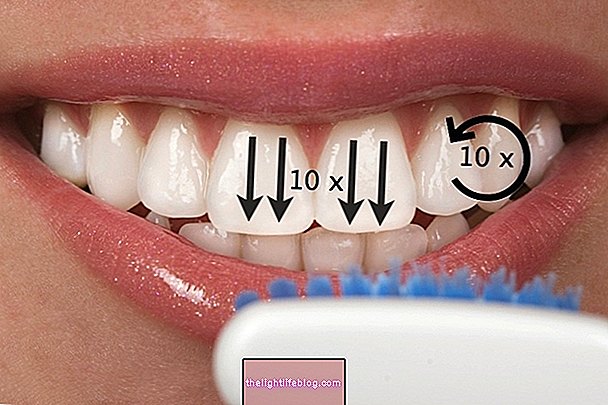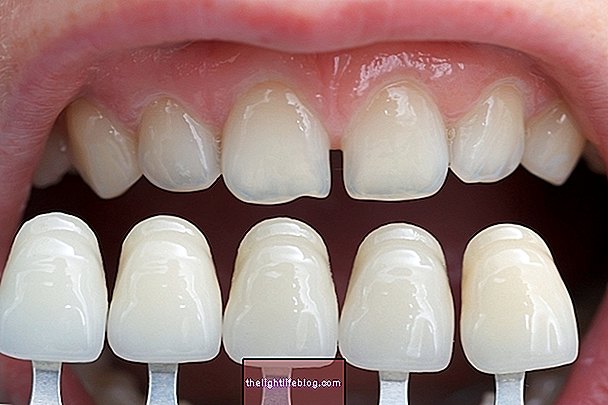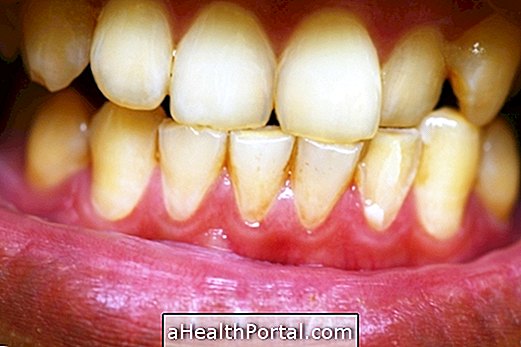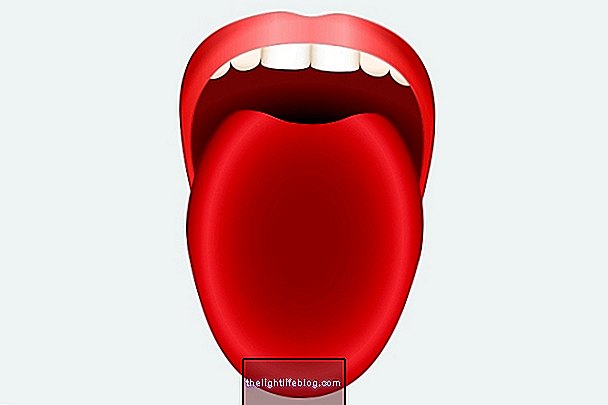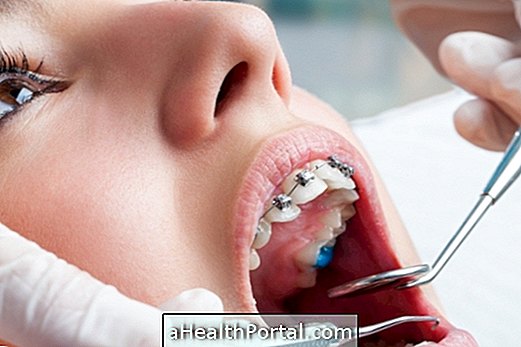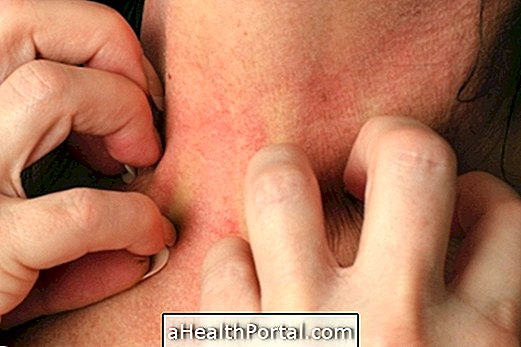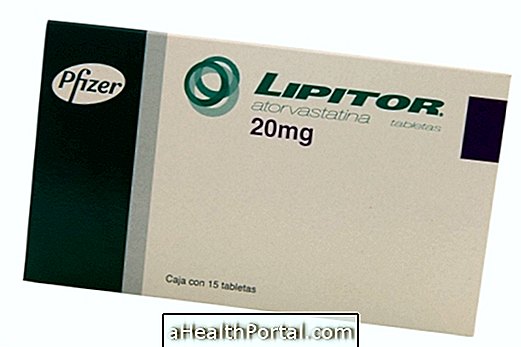Gum pain can be triggered due to a very aggressive brushing of teeth or incorrect use of dental floss, or in more severe cases can happen due to diseases like gingivitis, thrush or cancer.
Treatment consists of solving the problem that causes gum pain. However, measures can be taken to prevent and relieve it, such as good oral hygiene, correct nutrition or the use of an antiseptic and healing elixir.

1. Poor oral hygiene
Poor oral hygiene habits can cause dental problems that cause gum pain, such as gingivitis, abscesses, or cavities. So it is essential to brush your teeth at least 2 times a day, especially after meals, flossing and a mouthwash, such as Listerine or Periogard, for example, to completely clean the mouth, removing as much bacteria as possible.
In addition, it is also important to brush your teeth without too much force, preferably using a soft brush, so as not to damage the gums. Here's how to brush your teeth properly.
2. Use of appliances and prostheses
Apparatus and prostheses can cause problems in the gums because there is more accumulation of food debris and microorganisms, which can lead to infections. In addition, if these devices are poorly adapted can cause swelling, inflammation and toothache and jaw pain and pain in the gums.
3. Hormonal changes
In women, hormonal oscillations often occur, such as during puberty, during the menstrual cycle, during pregnancy and during menopause, which can affect the gums.
During puberty and pregnancy, the amount of blood that flows into the gums is greater, making them swollen, tender or painful, and at menopause hormone levels decrease, causing bleeding and pain in the gums and changes in color.

4. Thrush
If gum pain is accompanied by a whitish color on the tongue and inside the cheeks, it may be a disease of the thrush, which is caused by a fungal infection by a fungus called Candida albicans, being more common in infants because they have the lowest immunity .
The treatment for the disease of the thrush is the application in the affected region of an antifungal in the form of liquid, cream or gel like niastin or miconazole, for example. Learn more about this treatment.searches streptase
5. Aphthae
Canker sores are small painful lesions that usually appear on the tongue and lips, and may also affect the gums. They can be caused by mouth sores, acid or spicy foods, vitamin deficiencies, hormonal changes, stress, or autoimmune disorders.
Thrush tends to be treated with a scar and antiseptic gel or mouthwash, and it tends to disappear in about 1 to 2 weeks, but if this does not happen one should go to the dentist. See 5 infallible tips to cure thrush.
6. Gingivitis
Gingivitis consists of an inflammation of the gums due to the buildup of bacterial plaque on the teeth, causing pain between the teeth and redness. It usually happens because oral hygiene is not adequate, or due to other factors such as cigarette use, cracked or split teeth, hormone changes, cancer, alcohol, stress, mouth breathing, poor diet, excessive sugar intake, diabetes mellitus, some medicines or insufficient production of saliva.
If untreated, gingivitis can lead to periodontitis, so it is important to go to the doctor as soon as the first symptoms develop such as pain, redness and swelling of the gums, unpleasant taste in the mouth, white spots on the gums, gingival recession or the presence of pus between the gums and the teeth.
7. Abscess
In the presence of infections in the root of the tooth, an abscess may form in the mouth, which consists of a pocket of inflamed tissue with pus, which can cause intense pain and swelling of the gums. In these cases you should go to the dentist immediately.
8. Cancer
Cancer of the mouth can begin on the tongue, inside the cheek, tonsils or gums, and may have the appearance of a cold sore at an early stage, which never heals. It is therefore important to see a doctor if the cold does not disappear after about 1 to 2 weeks. See how the cancer treatment in the mouth is done.
9. Wisdom tooth
The birth of the wisdom tooth can also cause pain in the gums, which happens around the age of 17 to 21 years. If you do not have other associated symptoms, and if the pain is not very intense, it is perfectly normal for it to happen.
To relieve the pain you can apply a gel with benzocaine for example or rinse with an anti-inflammatory elixir.

When to go to the doctor
If gum pain persists for a long time and is accompanied by bleeding, redness and swelling of the gums, gingival recession, pain when chewing, loss of teeth or tooth sensitivity to cold or heat should go to the doctor to do the proper treatment .
How to treat
The ideal is to go to the doctor as soon as the first symptoms appear, however, gum pain can be alleviated by adopting the following measures:
- Opt for softer brushes;
- Use an oral antiseptic, healing or anti-inflammatory elixir;
- Avoid spicy, sour or salty foods;
- Use a gel directly on the gingiva, with benzocaine, for example.
In case the pain is very intense, one can take analgesics like paracetamol, for example.
Home Remedies

A good way to relieve gum pain is to make mouthwash with a solution of warm salt water several times a day. In addition, there are other home remedies that can help in pain, such as:
1. Salva oral elixir
Salva has antiseptic, anti-inflammatory and healing properties, so it is ideal for relieving pain in the gums.
Ingredients
- 2 teaspoons of dried sage;
- 250 ml of boiling water;
- half a teaspoon of sea salt.
Method of preparation
Put 2 teaspoons of dried syrup in a glass of boiling water and let stand for 15 minutes, then strain, add the sea salt and let cool. You should rinse 60 ml after brushing your teeth and use within a maximum of 2 days.
2. Hydraste and myrrh paste
This paste exerts an intense healing action on inflamed and painful gums, and can be prepared as follows:
Ingredients
- Myrrh extract;
- Powder of hydraste;
- Sterile gauze.
Method of preparation
Mix a few drops of myrrh extract into the powder of hydraste to make a thick paste, and then wrap in a sterile gauze. Place on the affected area for one hour, twice a day.
